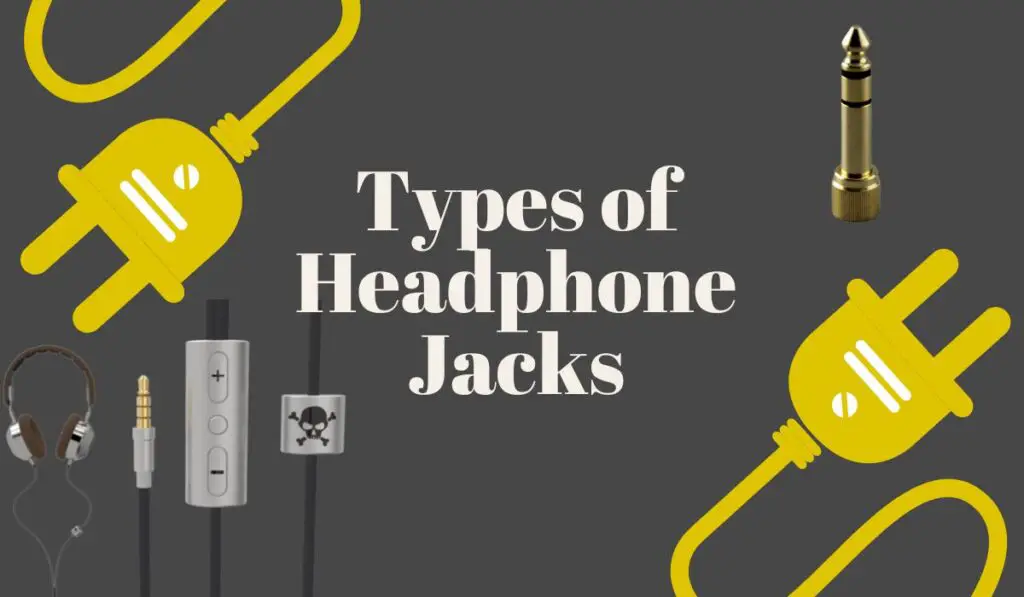
Before we tell you about the different types of headphone jacks, there are two key terms you need to know about- plug and jack.
“Plug” is the male part. “Jack” is the female part. You insert the plug into the jack. It’s that simple.
What is a headphone jack? A headphone jack is the plug of the headphone that connects to the respective jack on the audio device to receive audio signals.
There are different types of headphone jacks- the regular circular ones, the most commonly seen USB jacks, and the trendy wireless Bluetooth jack. But before we dig into that, you should know:
What are TS, TRS, TRRS, and TRRRS connectors?
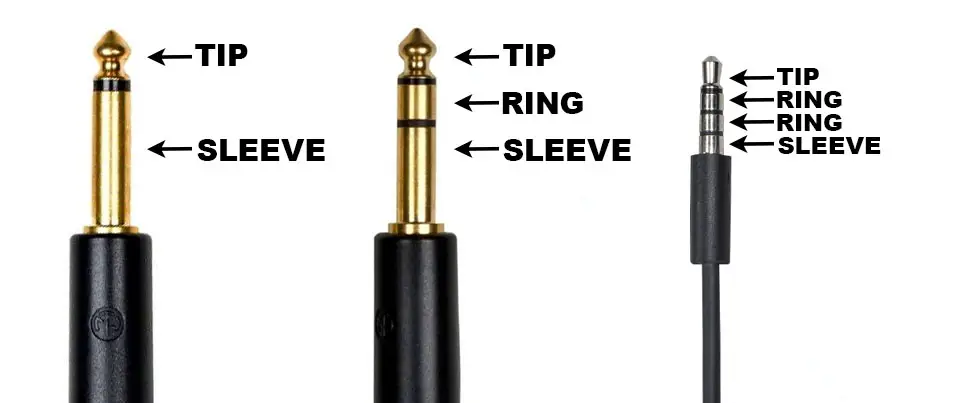
TS connector: The T stands for “tip” and S for “sleeve”.
It is a bi-conductor plug used for carrying mono signal through the “tip” conductor and the “sleeve” is the common ground.
Mono vs Stereo: Mono refers to the use of a single channel to transmit the audio signal whereas Stereo refers to the use of left and right channels to transmit the signal.

TRS connector: The T stands for “tip”, R for “ring” and S for “sleeve”.
It has 3 conductors that carry mono balanced audio ( the “tip” is positive and the “ring” is negative) or stereo unbalanced audio (the “tip” is left audio and the “sleeve” is right audio).
Balanced Vs Unbalanced: Balanced means there are two signal wires with opposite polarity besides the ground wire whereas Unbalanced means there is a ground wire and one signal wire.
TRRS connector: The T stands for “tip”, the two Rs for “ring” and S for “sleeve”.
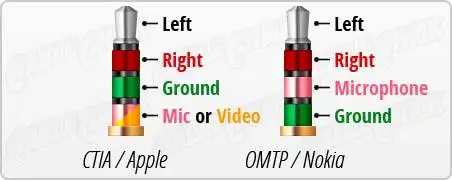
It has 4 conductors to give stereo unbalanced audio: the “tip” and the “first ring” are used for left and right audio, the “second ring” is for ground, and the “sleeve” is for the microphone (conform to the CTIA standard for Apple). As per the OMTP standard, the microphone is followed by the ground (altered positions) and the rest are the same.
TRRRS connector (rare breed): T stands for “tip”, the three Rs for “ring” and S for “sleeve”.
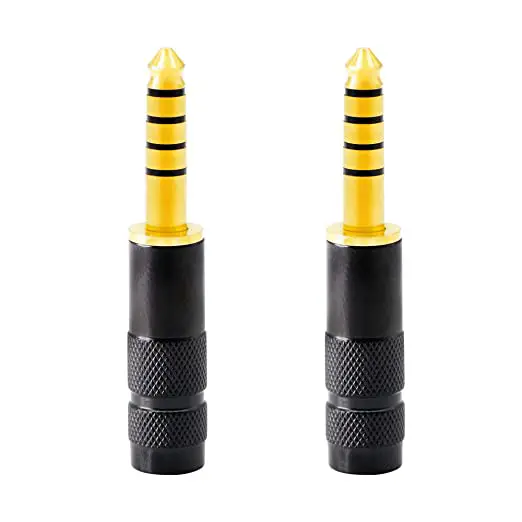
It has 5 conductors to support balanced stereo audio with negative and positive left audio followed by negative and positive right audio then a common ground.
Types of Headphone Jacks: Circular Plugs
6.3 mm Jack (quarter-inch jack)

The 6.3mm jack or 1/4 -inch jack is the largest, oldest type of headphone jack. It is used as a standard interface for most equipment. Its length ranges from 30mm to 31 mm (1.18 inches to 1.22 inches).
This type of jack is mainly found on amplifiers for musical instruments (example: you’ve probably used a 6.3mm jack when you connected an amplifier to your guitar).
The 6.3mm TRS type is used in professional headphones (also in recording studios). It’s also used on mixing consoles and audio interfaces. You can also find the 6.3mm jack on amplifiers.
Headphones Example: Sennheiser HD 560S Over-The-Ear Audiophile Headphones
3.5 mm Jack (1/8-inch jack)
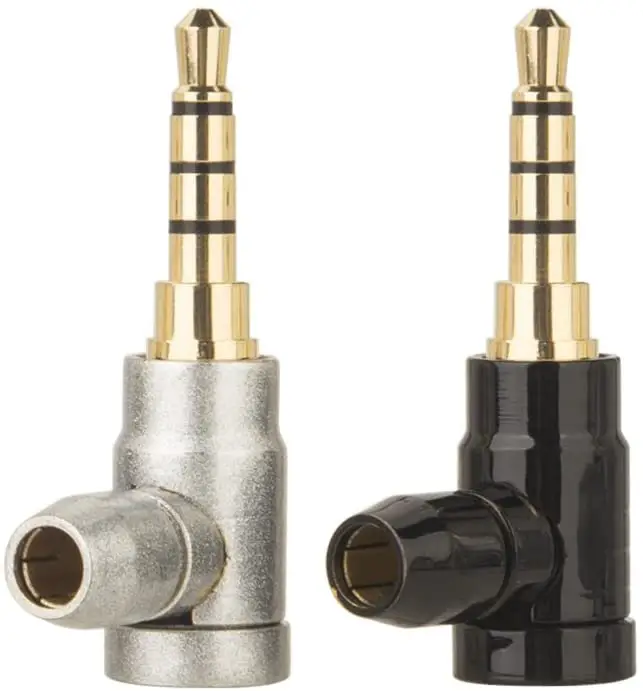
The 3.5 mm or 1/8-inch jack is the smaller version of the quarter-inch jack and the most common type of headphone jack today. It has the largest variance in length, ranging from 14mm to 17mm (0.55 inches to 0.69 inches). Most headphones are pure analog devices driven by the amplifier in the audio source, hence, they mostly use a 1/8-inch jack (generally of 15mm length).
The 3.5mm TRRS type is mostly used in regular-use headphones. You can find the TS type on musical instruments like electric guitars and aviation radios.
Headphones Example: EarPods with 3.5mm Headphone Plug
4.4mm Jack
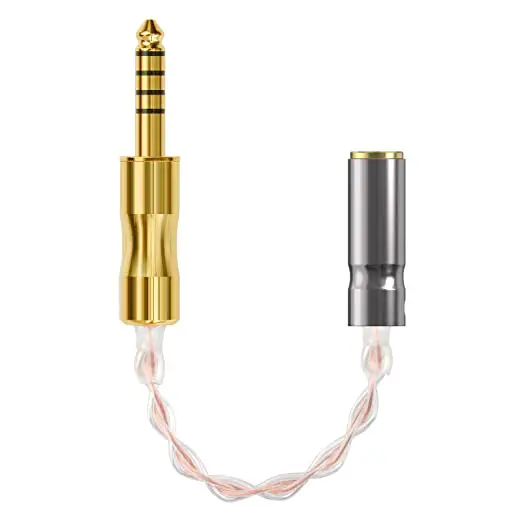
The 4.4mm jack is not as common as the 6.3mm or 3.5mm jacks. Its size is in between a 3.5mm and an XLR jack (more on XLR below).
This type of jack is mainly used by professionals in the music industry and even audiophiles. You can also find it in the telecommunication field.
The TRRRS type (rare breed) is mostly found on 4.4mm jacks (also called pentaconn connectors).
Headphone Example: Sennheiser HD820 Over-The-Ear Audiophile Headphone
2.5 mm Jack
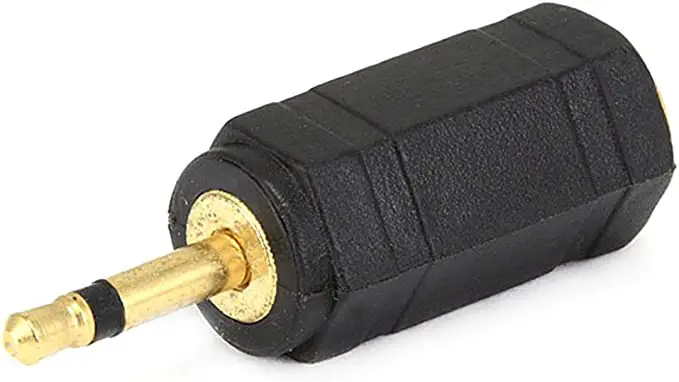
The 2.5mm Jack, also known as a sub-mini conductor, is the least common type of headphone jack you can find today. Due to its smaller size which is prone to break easily, it’s not widely preferred. You can still find it in a few models.
Generally, this type of jack is used are two-way radios, cordless landline phones, and video cameras.
You’ll find 2.5mm TS type connected to musical instruments like acoustic guitars and other string instruments.
Headphones: AGPTEK Noise Cancelling Binaural Headset
Quick Comparison
| Headings | 6.3mm | 3.5mm | 4.4mm | 2.5mm |
|---|---|---|---|---|
| Commonality | Largest of all the headphone jacks | Most commonly used headphone jack | Quite an uncommon headphone jack | Smallest of the lot |
| Also described as | Quarter-inch jack | Mini-jack (miniature of 1/4-inch jack) | In between 3.5mm and XLR | Sub-miniature or micro jack |
| Used in | Amplifiers (mostly), professional headphones, digital to analog converters | Smartphones, laptops, PCs, and portable audio players | Music industry for professional purposes, telecommunication, and audiophiles | Two-way radios, cordless landline phones, and video cameras |
| Overall pros | Connect audio without any hitch, more contact surface, resistance to damage, more standardized than 3.5mm, stronger, reliable, and robust. | More practical, good conductivity irrespective of power requirement, flow not more than 300 ohms, cheaper to manufacture. | Aids in working the headphones to their full potential, sturdier and harder to break than 2.5mm, better channel separation in theory | Marginal manufacture cost-benefit, requires lesser space (in theory) |
| Overall cons | Bigger in size, more difficult to carry around, too large to use with small devices | Sub-optimal contact resistance, not suitable for high-frequency devices, more expensive than USB cables | Bigger size makes it incompatible with most practical/daily use devices | Prone to snap at the slightest pressure, fading away from the market |
Other Types of Headphone Jacks
Lightning Audio Jack
The Lightning Audio jack is the newest type of headphone jack specifically designed for Apple devices (iPhone iOS 8.4 and later versions). It’s basically the charging port of Apple gadgets.
The main benefit of this type of jack is that it has a built-in DAC to produce perfect sound without any distortion. As compared to the most commonly used 3.5mm jack, the Lightning jack transmits full sound without any compression.
Example: JSAUX Lightning to 3.5mm Adapter
USB Jack
The USB port is present in almost every smartphone, laptop, tablet, and PC that is used to transfer files, but the USB headphone jack in particular is rarely found (mostly seen in gaming headsets).
The USB jack has a built-in amplifier so the sound emitted is clearer and well-defined. However, it requires high power and quickly consumes the battery.
Nowadays, the USB Type-C jack is the most common jack found in devices. It’s the same as the original USB jack except it has a smaller locking clip on one side.
Example: USB Headset
Bluetooth Jack
Bluetooth is the most common type of headphone jack used today mainly ‘cause of the convenience that comes with the “wire-free life”.
When you have no wires on your headphone, you’re using a Bluetooth jack. It refers to the wireless transmission of audio signals.
It might be wrong to consider it as a “headphone jack” ‘cause there’s no actual jack/plug, to begin with. However, it does a similar job as the other jacks and can be considered as a big leap in the field.
The major disadvantage here is the audio quality. It does not offer as good audio quality as the other jacks (the difference might be unnoticeable but it is there). You’ll not find a Bluetooth connection in professional headphones because of the sub-par sound quality.
Also, if you’re watching a video with your Bluetooth headphones on, you may notice that the audio is not in sync with the video. It’s ‘cause of the standard SBC codec that some of the headphones feature (you need a pair with a low latency codec to avoid this nuisance).
But, with the rapid improvement in technology, brands are coming up with better audio quality Bluetooth headphones. It won’t be surprising if they fully replace the traditional plugs one day.
Headphone Example: Bose SoundLink Wireless Headphone
Here’s a short summary on the different types of Headphone jacks:
How to find the compatibility of different jacks with different plugs?
The best way to find out the compatibility is by putting the plug into the jack. While there are some jacks that are compatible with other plugs, experimenting with different plugs into different jacks can be dangerous and may cause damage to your device.
However, here are some plugs that work perfectly fine with different jacks:
- A 3.5mm TRRS CTIA standard plug into a 3.5mm TRS jack as they have a similar wiring scheme.
- TRS and TRRS work fine together as the common ground connects.
You can experiment with other plugs and jacks to see if they work or not. However, one such pair is a big NO-NO. CTIA and OMTP standards will NEVER work together.
FAQs
What is a 3 Pole Mini?
It’s basically a name for the 3.5mm TRS jack. Sometimes, it’s called Stereo Mini.
How can you tell the difference between a 3.5mm or a 2.5mm plug?
It is hard to tell the difference especially when you’re not well aware of the two types. The easiest way to tell if it’s a 3.5mm jack is by inserting it into your phone jack as most smartphones come with a 3.5mm headphone jack. The 2.5mm plug looks more like a pin and it’s mainly for headsets.
What is the universal audio jack?
The universal audio jack is the TRRS connector that gives stereo sound and microphone signals.
What type of headphone jack/plug should you use?
The most widely used is the 3.5mm TRRS type so that’s what you should go for if it’s for casual use. Professionals use 6.3mm or pentaconns or other higher-quality jacks.
Conclusion
So far, these are the types of headphone jacks used in today’s devices. The most common types you’ll find today are the 3.5mm TRRS jack, USB Type-C, and Bluetooth connector.
To know more about headphones, you may read this article: What Qualities You Should Check Before Buying a Headphone.